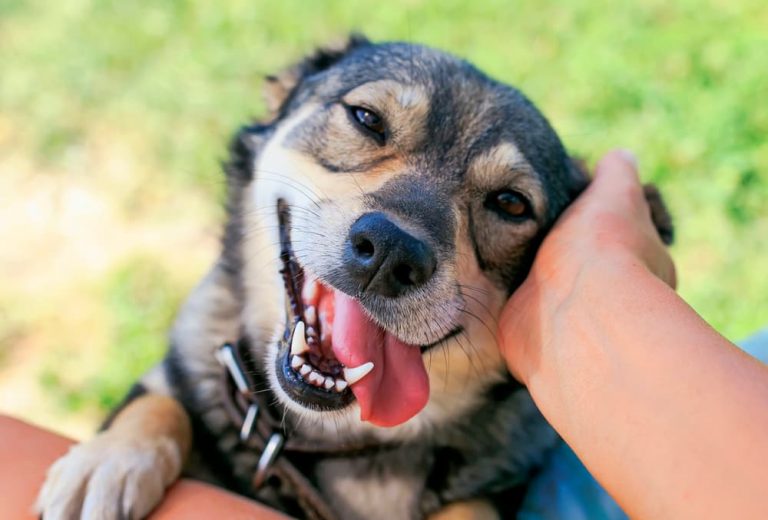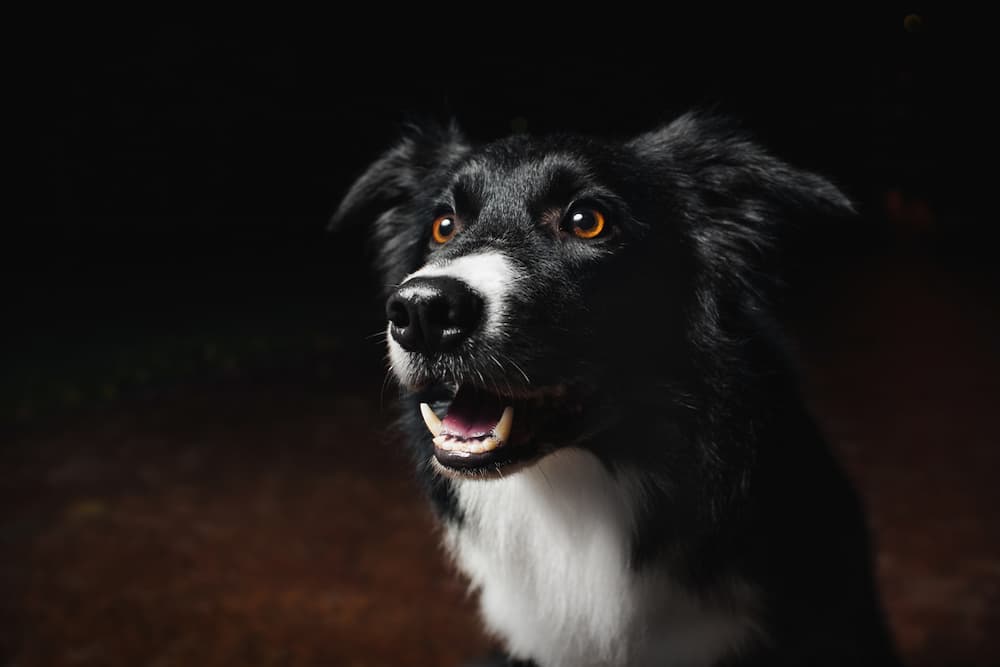Dog Vision: All the Facts You Need to Know

Puppy dog eyes are irresistible. Dogs know it, and they quickly learn they can get away with just about anything if they just give you that look. But when they do shoot you those adorably sad, soulful gazes, what are dogs really seeing?
For a long time, it was thought that dogs could only see in shades of gray. But now we know that’s simply not true. Dogs may not see exactly what we do when they look around. But they use all of their senses—including their vision—to take in a world that’s vibrant, colorful, and anything but dull.
Dog Vision: Understanding Canine Eye Anatomy

Dogs’ eyes are structurally very similar to human eyes. The colored part is the iris, which surrounds the dark round pupil and controls how much light passes through that opening. Next, the light flows through the lens, a small ball of special fibers that bend and stretch to focus the light, projecting a sharp image onto the sensitive cells of the retina.
Retinal cells come in two varieties: cones and rods. Broadly, cones detect color when there is adequate light. Rods detect movement and can function with very minimal light (night or dark rooms). All of these components are covered by the cornea, which is the clear dome that protects the front of the eye in both dogs and humans.

There are also some important structural differences between dog eyes and human eyes. First is the nictitating membrane, commonly called the third eyelid, which dogs have and humans don’t. This is an extra band of tissue behind the lower eyelid that helps protect the eye from damage.
Another key difference: Behind the retina, at the very back of the globe, dogs have something called the tapetum lucidum—a reflective layer that shines light back onto the retina in low light situations to help improve vision. At night you can see this as a white or blue reflection of the eyes when light is shined on them. Some dogs—especially those with blue eyes—may lack a tapetum lucidum and therefore experience the “red-eye” phenomenon in photographs, just like some people do.
Dog Vision Facts and Answers

While humans are very visually-oriented creatures, dogs depend more on a combination of senses—smell, hearing, and vision—to navigate the world. But that doesn’t mean dogs are at a disadvantage when it comes to experiencing the world around them. Their sharp ears and superior sense of smell more than make up for any vision deficits in color perception or acuity. Dog eyes can also detect movement more easily and see better in low light, two adaptations that were important in their evolutionary history as dawn and dusk hunters.
Do Dogs Have Night Vision?

In a pitch-black room, you and your dog would see the same thing: nothing. However, dogs are better able to see in low light than people. This is because they have more rod cells in their retina to pick up light. Humans have more cone cells in their retina, which are great for detecting color during the day but function poorly in low light. In dogs, the tapetum lucidum—a reflective surface behind the retina—also helps the rod cells to absorb more of any available light. Dogs cannot see any better than humans in total darkness but can see better in dim moonlight or a darkened room.
Can Dogs See Color? Are Dogs Colorblind?

Yes, dogs can see color. However, their color spectrum is smaller and less vibrant than what most humans can see. Here’s why: In the retina, cone cells are in charge of detecting color. Humans have three varieties (red, blue, and yellow) that combine to make all of the colors of our visual spectrum. This is known as trichromatic vision. Dogs, like many other mammals, lack the red-detecting cone cells and can only see from the yellow to the violet parts of the rainbow including shades of blue and green. This is called dichromatic vision and is comparable to what people who are red-green colorblind see. Dogs also may not be able to see the richness of colors as well as people can.
How Far Can Dogs See?

Dogs are very good at detecting movement, even at long distances. However, their visual acuity is limited. Visual acuity is how clear images are at a given distance. For example, 20/20 vision means you can discern complex shapes at the set human standard. Dogs are estimated to have 20/75 vision, meaning they have to be 20 feet away to discern details that most people can see at 75 feet. Some breeds, including German Shepherds, Rottweilers, and Miniature Schnauzers are more likely to be near-sighted than other breeds. Typically this doesn’t impact how they interact with people and their environment.
Do Dogs Have Depth Perception?

Depth perception is the ability to perceive the distance between objects and see them in three dimensions. In both humans and dogs, this is made possible by the overlapping visual fields of both eyes. People generally have about 120-140 degrees of overlap (out of 200 degrees of vision where 360 would be a full circle) but dogs only have about 30-60 degrees of overlap, meaning canine depth perception is about half as acute as it is in humans.
Because dogs’ heads come in so many shapes, depth perception differs between breeds. Long-nosed breeds such as Greyhounds have less depth perception than dogs with shorter faces and more forward-facing eyes such as Pugs. The trade-off is an enhanced field of view. Eyes on the side of the head allow dogs to see more of the world at once, as much as 270 degrees.
Cat Vision vs. Dog Vision: Key Differences

Overall, cat and dog vision is very similar. But there are a few key differences that largely relate to behavioral distinctions between dogs and cats. The first thing you might notice when comparing dog eyes and cat eyes is that cats have a vertical pupil while dogs have a round one. It is theorized that this may be due to the fact that cats are ambush predators, as the shape may aid in detecting depth and movement. Cats are even more near-sighted than dogs, which makes sense because keen up-close eyesight is more important to a hunter who waits to pounce. To improve the accuracy of that pounce, cats are also equipped with better depth perception. Dogs seem to have better color detection than cats.
Common Dog Vision Problems

Most dog vision problems are temporary and easily treatable by a veterinarian. But that doesn’t mean you should dismiss potential eye issues or postpone treatment. Eyes are sensitive and irreplaceable, so it is important to have your veterinarian examine your dog if you have any concerns.
Here are some of the most common eye issues dogs face:
Cloudy Lens
Lenticular sclerosis, or a soft haziness of the lens, is normal in dogs as they age. It does not cause a problem and does not need to be treated.
Corneal Ulcers
Scratches or irritation to the covering of the eye. Usually easily treated by a veterinarian with medication but can become chronic especially in short-faced (brachycephalic) breeds.
Entropion and Ectropion
Rolling in or out (respectively) of the eyelid. This can irritate the cornea.
Dry Eye
When dogs do not produce enough of the liquid component of tears, material can build up on the eye. The medical term for this is keratoconjunctivitis sicca (KCS). It is treated with life-long application of eye drops or daily pills, depending on the cause.
Cherry Eye
Cherry eye is a chronically elevated third eyelid that is visible above the lower eyelid. This is most common in short-faced dogs. Depending on the cause, severity, and duration it may be treated medically or surgically.
Cataracts
A cataract is when the lens of the eye becomes increasingly opaque, causing blurry vision. Just like in people, dogs can have cataract surgery to remove the damaged lens and restore vision. Some cataracts are caused by diseases such as diabetes.
Tear Staining
Though not truly a disease of the eye, many dogs develop moist staining below the eye. This is due to ineffective or incomplete draining of the tear ducts. Tear staining can lead to skin infections around the eye. Gently wiping the area daily with a clean soft cloth can reduce the risk of infection.
There are less common and breed-specific eye problems that can affect dogs, including different types of blindness. If you purchase a pure-bred dog it is important to have their eyes evaluated or their genes tested if the breed is known to have eye problems.
How to Protect Your Dog’s Eyes

The most important thing you can do to protect your dog’s eyes is to take them to the veterinarian immediately if you have any concerns. Common signs of a problem include rubbing, squinting, discharge, elevated third eyelid, and redness. Common signs of vision loss include being hesitant to jump onto or off furniture, bumping into things, and squinting in the sun. Any of these signs means a veterinarian should evaluate your dog’s eyes.
Time is a factor when treating eye problems. The longer you wait to have your dog evaluated by a veterinarian, the more risk there is of permanent damage.
Remember, your regular veterinarian can perform a full ophthalmic exam and provide appropriate medication or treatment. Sometimes a board-certified veterinary ophthalmologist is needed to fully address the problem or provide the solution. But as long as you maintain regular checkups and alert your veterinarian as soon as you notice any potential eye issues, your dog’s eye health and vision should be in good hands.









